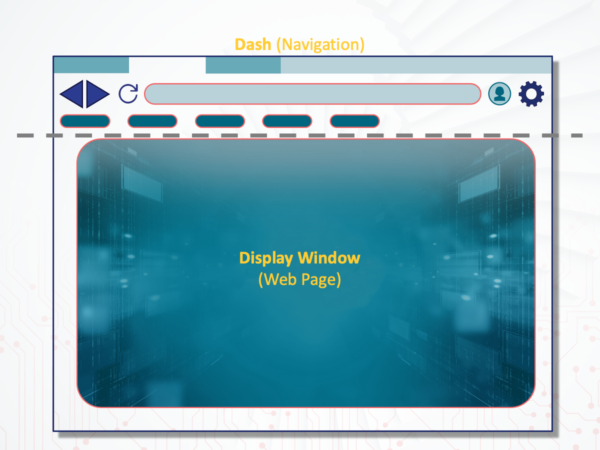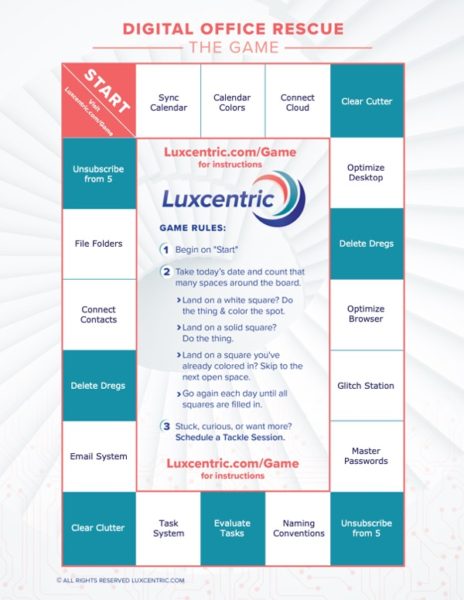Optimize Browser Prerequisite
When your browser is fully optimized it will open to the page or pages you expect and with no more than a click or two you are able to get to all the things you need.
No matter how many online tools you use your browser can keep them all organized in one central location.
What you need to know:
- Know what a browser is and what it is used for
- To search for information
- To access an online tool
- To interacting socially online
- To play games
- To shop online
- Know which browser you are using and why
- Chrome
- Edge
- Firefox
- Safari
- Know the parts of your browser and what they do
- Display Window: The visual display of the web page you are browsing
- Dash: The part on top with the controls
What is a browser?
To surf the Internet and work online “in the cloud”, you need a browser. Chrome, Edge, Safari, and Firefox are all browsers. These programs are like different brands of cars you use to drive about the internet.
For many people, this is the most important program on their computer, and for some, the only one they really need.
Making a few intentional adjustments to your favorite browser will save you hours and prevent loads of technology frustration.

The purpose of a browser is to search for information, access online tools, interact socially online, play games, shop, and generally get things done.
The primary feature that makes a browser a browser is the Navigation Field where you enter the address of a web page or a subject you wish to research. This field is located in your Browser’s Dash. Take a look at the dash in the browser you are using right now and see if you can find the Navigation Field.

When you type a web address or search topic into the Navigation Field and hit enter on your keyboard your browser will do all kinds of magical things to show you the content of that website page and allow you to interact with it. You will see the web page in the Browser Display Window.
What a browser is NOT
Your browser is NOT a search engine
When you type something into the Navigation field that is not an actual web address your browser will ask the Search Engine to offer you options that might fit your query. Depending on your browser settings it may use Google, Bing, DuckDuckGo, or a host of other search engines to give you suggestions.
Your browser is NOT your email
You may open your browser to check your email, you may use an email account associated with the same brand as your browser, but they are not the same thing. Many people use the Chrome Browser to check Gmail email and the Edge Browser to check a Microsoft 365 or Outlook email account (Hotmail, MSN, Outlook), but you don’t NEED to.
Your browser is NOT your computer
It is possible that the only thing you use on your computer is your browser, but it is just a program on your computer. A Chrome book, for example, uses the Chrome browser technology to do practically everything.
Your browser is NOT the internet
Your browser can read the internet content and display it in a way you can access, but it is not actually the internet itself. To be useful it must be able to detect and connect to the internet through your computer or smart device.
Your browser is NOT a web page
You need a browser to read and interact with web pages.
Web-based tools you use or social platforms you visit are websites and the pages can be accessed via a browser.
Which browser you should you use and why?
Which browser is the best…for you? And how do you choose?
The browser you choose to use for most of your internet navigating needs should make your life easier NOT harder and there are several very practical considerations.
First consideration is the technology
What is your level of tech savvy?
Do you like to figure out how to do stuff out on your own or do you prefer to ask your favorite techie? For my people, I usually recommend Chrome or Edge they do all the things most of my people need and are easier for me to support.
How well does the browser meet the standards you need?
More and more companies are designing websites based on browser technology and browser technology is shifting and adjusting to suit the trends in website development. It is a very interdependent relationship. Things change rapidly, and you will want a browser that can keep up.
To narrow your options, choose between Chrome, Edge, Firefox, and Safari.

Second Consideration – Do you need to keep things separate and synchronized?
Chrome and Edge are now comparable in most features. The feature that bumps them to the top of the list is the ability to have different profile accounts open at the same time. This is useful if you want to keep your professional browsing separate from your personal browsing.
Firefox and Safari both have profiles that can sync between devices, but you cannot have multiple profiles open at the same time. (This may change in the future)
NOTE: Signing in to your browser profile is what enables you to synchronize your browsing preferences and favorites/bookmarks between devices.
Third Consideration – Your other tools
To get the most benefit from your online tools it is best to stay on brand if you can.
Chrome works best with Google Workspace and Edge works best with Microsoft 365.
Firefox is a good neutral party but lacks some of the brand benefits.
Safari can only be used on Apple products (MacBook, iPad, iPhone) it syncs well if you are using only Apple products.
Fourth Consideration – Your instincts and preferences
If you simply prefer one browser over another then go for it. Your instincts matter.
Chrome is currently the most popular and other browsers are gradually shifting to the same technology, look, and layout that Chrome developed.
Edge comes with the Windows computer (PC) and has improved over the years. It is worth a second look for those who have moved away from it, especially if you are using Microsoft 365 products online.
Firefox is a good neutral party, and it is a non-profit underdog. It does not have the resources that the larger browsers have and sometimes has trouble keeping up in terms of ease of use and security. Many people who use Firefox do so for philosophical reasons and are comfortable navigating the troubleshooting required to go against the masses.
Safari is the browser that comes with every Apple device and usually does the job well if you do not need anything special. It looks different than the other browsers, but everything is still there if you know where to look for it.
Whichever browser you choose get comfortable with how it looks and how it behaves. The recommended four browsers mentioned above have everything you need to successfully navigate the internet.
What are the parts of your browser?

The Display Window
The visual display of the web page you are browsing
This is where you view and interact with web pages.
The Dash
Over time Browsers have added more features to make navigating the internet easier and more fun. Most of these features can be found on the Browser’s Dash.
The dashboard of your browser is where all the controls are found. Sometimes you can do the same things from a page in the window, but you have less control. You have more control of the dash, and it will be more consistent.

Take a look at the dash in the browser you are using to read this post and Identify the elements. (Profile, Forward and back, refresh, tabs, settings.)
Profiles
Your Browser Profile is what keeps everything synchronized so you can log into your browser from anywhere and have all your stuff arranged the way you like it. Profiles also allow you to access multiple Google Workspace accounts and Microsoft 365 accounts without getting meshed and confused.
Access to your browser profile (except Safari) is usually located in the upper right corner of your browser dash.
NOTE: You may see 2 profile images; your browser profile will be the one on the top, on the Dash, not in the Display Window.
Every Gmail/Google account comes with a Chrome browser profile. Every Microsoft 365 account comes with an Edge profile. You will use your associated email account and password to access these accounts.
When you will log into your Apple products, Mac book, iPhone, or iPad your Apple ID is automatically considered your Safari browser profile.
For Firefox you need to proactively set up a profile and can use any email address as your profile account.
You do not need a browser profile to make your browser work well. The benefit lies in synchronization between devices and if your computer fell into the sea your browser information (favorites, passwords, history) would be lost if you did not log in to your profile.
Navigation Field – URL – Web address field
This field is what makes a browser a browser. Usually found in the middle of the Browser dashboard. In this field, you can enter a web address and hit enter on your keyboard to visit a web page. You can also enter a topic or search parameters to use the browser’s search feature and find a list of potential web pages that match your search.
Backward and forward
These left and right-facing arrows allow you to go back to the last or several last pages you visited and then forward again. They are tab-related, so if you click a link and it opens a New Tab the back button won’t take you to the original page, but you can just toggle back to it because the old Tab will remain open.
Refresh
This swirly arrow thing is used to tell your browser to try again. Sometimes a webpage will not load properly. Refresh is the first step toward Troubleshooting problems online.
Tabs
Tabs are the coolest thing ever. They are usually at the top of your browser and represent open web pages. You can have several open at the same time and jump back and forth without losing your place on another web page.
This is a wonderful productivity feature, and each tab will take up computer resources as it runs in the background. The best way to use tabs is to open the web pages you visit the most throughout your day, like your email, calendar, and project management page so you can toggle between them easily.
NOTE: The more tabs you have open the more resources your computer will use and the slower and more glitchy your computer/browser experience will be. In Chrome and Edge you can Rt. Click/Secondary Click on the blank spot to the right of your browser tabs to open your browser Task Manager and see how much resources you are using.
Favorites/Bookmarks
One of the most useful things you can do with your browser is set up your favorites bar, also known as your bookmark bar. Getting comfortable with this feature will allow you to quickly access the things you use every day and have a place you can store the webpages you will need to access “eventually”.
- Turn on your bookmark/favorites bar. NOTE: Every browser does this differently and the way it is done changes over time. See KB ARTICLE: Browser Adjustments for instructions
- Create top-level category folders in your bookmark bar. (Rt. Click/Secondary Click on the bookmark bar)
Favorites and bookmarks are used to help you organize and save the web pages you need to return to. They can get overwhelming and cluttered if not managed properly.
NOTE: When you click on a bookmark on your toolbar it will use the tab that is open to replace that website with the website programmed into your Favorites Entry. As a best practice, I recommend opening a new tab before clicking on a Favorites Entry.
Settings
Settings are the back-end options to make your browser behave the way you want it to. It is always a good idea to take a tour of the settings for any program or online tool you use.
Usually* found in the upper right corner of stuff. Look for a Settings symbol.

Read through the options you find in the settings section of your browser. You will find some useful things in there. Regularly touring the settings and options of any program or tool you use is always a good idea. Programs, like your browser, start with default settings based on what their users usually prefer. This changes as new features are added and old features drop off. Settings often hold new features you didn’t know you wanted (or needed).
*Except Safari. When Safari is active the settings can be found on the bar at the top of your desktop screen to the left. Click Safari, then preferences.
Extensions
Extensions are programs that can be integrated into a browser to extend the features of your browser. LastPass, Zoom, Loom, and many other web-based software tools offer extensions. It is a good idea to check your extensions and make sure you know what each one does for you.
Extensions are a point of danger and can be a way for less noble companies to do unpleasant things, so make sure you only install extensions from a reputable source.
Updates
You can see if your browser needs an update by checking the help menu in your settings or watch for the notification.
To keep you save your browser will occasionally need to update. When you get notice that your browser has an update available you should initiate it as soon as you can. This will make sure you have the latest version of privacy and malware protection, bug fixes and the newest features.
While updates cause changes in your browser that you may not be excited about, they are important. The good news is that big changes are rarer, and most changes are small and gradual, allowing you to get used to them.
Troubleshooting Steps
Things go wrong and knowing the steps you can take to fix them is a huge part of maintaining a well-functioning browser.
Common things that cause browsers to go wrong.
- Poor connection to the internet.
- Cache is full
- Browser is out of date
- The website you are trying to reach is down or cranky
Things you can do
- Refresh the browser
- Clear Cache
- Check for a browser update
- Reboot computer
- Reboot your internet
- Wait and try again later

See BLOG POST: Internet Troubleshooting for more detailed information.
Back to the Optimize Your Browser GAME SPACE
When your browser is fully optimized it will open to the page you expect, and you will be able to get to all the things you need with no more than a click or two. No matter how many online tools you use your browser can keep them all in one central location.
Check out the GAME SPACE: Optimize your Browser

Nicole Lux-Ritchie - Founder of Luxcentric
Nicole's mission is to help feminine professionals gain the technical
skills they need to grow their business and focus on their missions.
The focus of Luxcentric is on training practical strategies in the area of the core technologies.
EMAIL - FILES - CALENDARS - CONTACTS
For those of you who find this information useful and would like to contribute to the cause (and keep it ad free)...
Your mission, should you choose to accept it,
is to Rescue your Digital Office.

In this regular* email dispatch, you will receive the guidance you need to Rescue your Digital Office!
*about every other week


